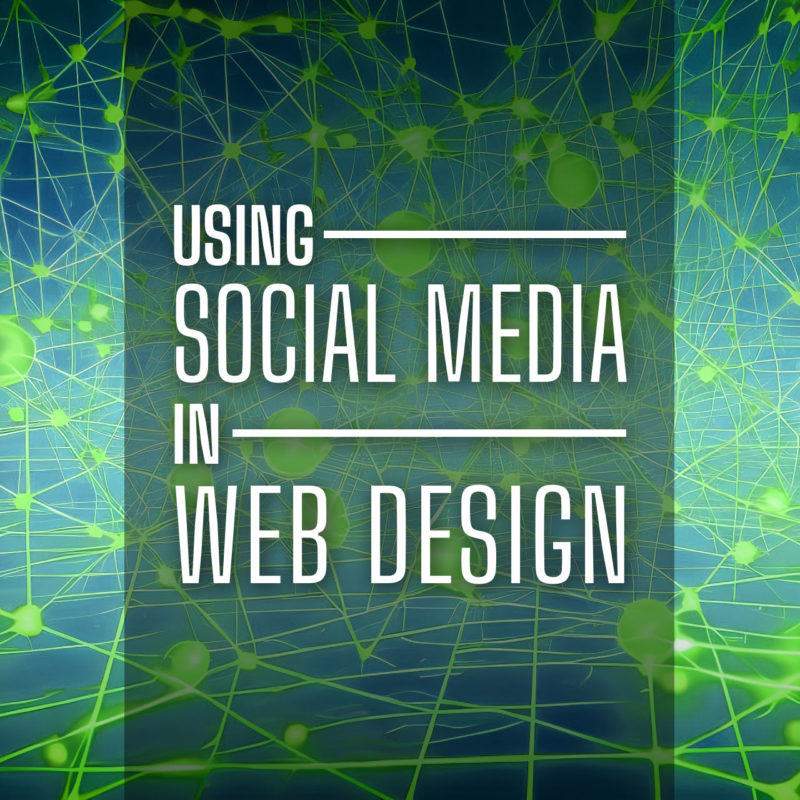
Social media has become an integral part of our lives, and as such, it has also become an important element of web design. Integrating social media into a website can provide a variety of benefits, including increased engagement, improved reach, and stronger brand recognition.
Getting Started With Social Media
When it comes to incorporating social media into your website, it’s important to first establish a presence on the platforms that are most relevant to your business. This may include Facebook, Twitter, Instagram, LinkedIn, and others. Not all social media platforms are created equal. Some are better suited for certain businesses than others. Do some research to find out which social media platforms your target audience is using, and focus on those platforms.
Social media can be a powerful tool for promoting your website and connecting with your audience. To get started, it’s important to fill in your profile information on each platform and make sure it accurately reflects your brand. This includes your logo, cover image, bio, and contact information. Once your profiles are set up, you can start engaging with your followers and sharing content. Don’t forget to include links to your website and encourage your followers to visit your site. It may take time to build a following, but consistent updates and engaging content can help you gain traction and grow your online presence.
Using Your Website to Grow Your Social Media Following
Once you have created your profiles, it’s important to include links to your social media accounts on your website. This allows visitors to easily find and follow your business on their preferred social media platform. Many web design platforms and tools offer built-in social media integration options, making it easy to add links to your profiles in a prominent location on your website.
Another way to use social media in web design is by incorporating social media feeds directly into the website. This can be done using widgets or plugins that pull in content from the website’s social media profiles. This provides visitors with a dynamic and constantly updated view of your social media activity, which can help to build trust and engagement. If you’re not updating your site on a regular basis (and you should be), this can help to keep your website from becoming stale.
Consider offering exclusive content or discounts to your social media followers to incentivize them to follow you. You can promote these offers on your website to encourage visitors to follow you on social media.
Using Social Media to Get More Website Traffic
One of the most effective ways to leverage social media in web design is by adding social sharing buttons or icons to the website. These might be placed in the header or footer of the website, or even within individual pages or blog posts. This encourages visitors to easily share the website’s content on their own social media profiles. Each share is like a personal endorsement to all of their friends and followers, which can massively help to expand your website’s reach and attract new visitors.
When you add new content to your website, you can utilize social media to promote it and drive traffic to your site. Share links to your new content on your social media profiles to let your followers know about it. Be sure to craft a compelling headline and include an eye-catching image to make your post stand out. You can also use hashtags related to your industry or topic to reach a broader audience. This can lead to increased website traffic and improved search engine rankings.
Resurfacing old content on social media is a great way to breathe new life into your website and increase traffic. Not all of your followers may have seen your content the first time around, so re-posting or sharing older posts can help you reach a wider audience. To resurface old content, take some time to review your past posts and identify evergreen content that is still relevant and valuable to your audience. Then, create new social media posts promoting that content, and schedule them to be shared on your social media platforms over time. You can also experiment with different messaging and visuals to see what works best to get people to engage with your content. Resurfacing old content is a simple but effective way to keep your social media profiles active and engaging.
Running contests and giveaways on social media can be an effective way to increase engagement and grow your following. To get started, determine what you want to achieve from the contest or giveaway, such as increasing your follower count or promoting a new product. Then, determine the rules, such as how users can enter, the deadline for entry, and the prize. Promote the contest or giveaway on your website and social media channels, and consider using paid social media ads to reach a wider audience. Be sure to comply with platform rules and regulations and disclose any necessary information to participants. Finally, track the results of the contest or giveaway to measure its success and use the insights gained to improve future social media campaigns.
Making the Most of Social Media
Social media can also be used as a tool for customer service and engagement. By responding to comments and questions on social media, businesses can build relationships with their customers and provide them with valuable support and assistance. Also, use social media to gather customer feedback from your most loyal followers. Ask your customers for their thoughts and opinions on your products, services, or website. This feedback can help you make improvements to your business strategy.
Paid promotions can be a powerful tool to reach a wider audience on social media. Platforms like Facebook, Instagram, and Twitter offer a variety of advertising options to target specific demographics and interests. Paid promotions can be in the form of sponsored posts, display ads, or promoted tweets, among others. Before investing in paid promotions, it is important to set clear goals and budget accordingly. Regularly monitor the performance of your ads and adjust your targeting and messaging as necessary to optimize your results.
Being consistent with social media updates is crucial to take full advantage of these powerful platforms. It’s important to have a set schedule for posting content to ensure that your followers are regularly engaged and informed about your brand. This also helps to establish a strong online presence and build a loyal following. Consistency in posting also ensures that your social media profiles stay active, and this can help improve your website’s search engine ranking by demonstrating your website’s credibility and relevance. You can use social media management tools such as Hootsuite, Buffer, or Sprout Social to synchronize your profiles and schedule your posts ahead of time.
Incorporating social media into your web design process can provide a variety of benefits for businesses, including increased engagement, improved reach, and stronger brand recognition. By using social media to its full potential, and engaging with customers on a regular basis, businesses can create a dynamic and engaging online presence to reach a larger audience.


